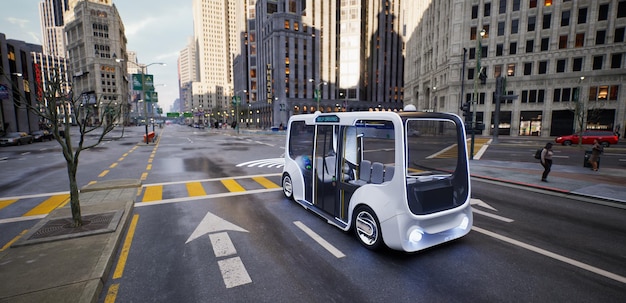Sustainable Transportation: Eco-Friendly Commuting in the US

Sustainable transportation offers US residents eco-friendly commuting options like biking, electric vehicles, and public transit, reducing carbon footprint and promoting healthier lifestyles.
Commuting in the US can significantly impact the environment. Embracing sustainable transportation: eco-friendly commuting options for US residents is crucial for reducing carbon emissions and promoting a healthier planet for future generations.
Understanding Sustainable Transportation
Sustainable transportation is about making choices that minimize environmental impact. It aims to reduce pollution, conserve resources, and promote public health while still allowing people to move efficiently.
What Makes Transportation Sustainable?
Sustainable transportation systems prioritize energy efficiency and reducing reliance on fossil fuels. They consider the full lifecycle of vehicles and infrastructure and aim to minimize waste and pollution.
- Energy Efficiency: Using less energy to travel the same distance.
- Reduced Emissions: Lowering greenhouse gas emissions and air pollutants.
- Resource Conservation: Minimizing the use of non-renewable resources.
- Accessibility and Equity: Ensuring transportation options are available and affordable for everyone.
By focusing on these key elements, sustainable transportation methods contribute to a healthier environment and a more livable society. Individuals, businesses, and governments all have a role to play in promoting and implementing sustainable transportation solutions.

Eco-Friendly Vehicles: Options for Commuters
Choosing fuel-efficient or zero-emission vehicles can significantly reduce your carbon footprint. Here are some of the best options available to US commuters.
Electric Vehicles (EVs)
EVs run on electricity, producing zero tailpipe emissions. They are powered by batteries and can be charged at home or at public charging stations. They contribute to cleaner air and lower greenhouse gas emissions, particularly when the electricity comes from renewable sources.
Hybrid Vehicles
Hybrid vehicles combine an internal combustion engine with an electric motor to achieve better fuel economy than traditional gasoline cars. They use regenerative braking to recapture energy and reduce fuel consumption.
- Plug-in Hybrids (PHEVs): Can be plugged in to charge their batteries, extending their electric driving range.
- Traditional Hybrids: Cannot be plugged in and rely solely on regenerative braking and the engine for charging.
- Mild Hybrids: Offer a smaller electric motor to assist the engine, providing modest fuel economy improvements.
Hybrid vehicles are a good stepping stone towards full electrification, offering a balance of fuel efficiency and range.
The Power of Pedal: Biking and Cycling
Biking is a fantastic option for short commutes and recreational activities. It’s not just eco-friendly but also offers numerous health benefits.
Benefits of Biking
Cycling improves cardiovascular health, reduces stress, and strengthens muscles. It helps reduce traffic congestion and air pollution, creating a healthier and more pleasant urban environment. You help to lessen your carbon footprint considerably.
Making Biking Safe and Practical
Plan your route in advance, choosing roads with bike lanes or lower traffic volumes. Wear a helmet, use lights and reflectors, and follow traffic rules. Consider an e-bike for longer commutes, as they provide electric assistance to make the ride easier.
- Route Planning: Use bike-friendly navigation apps to find safe and efficient routes.
- Safety Gear: Always wear a helmet and reflective clothing.
- E-Bikes: Great for longer commutes or hilly terrain.
- Bike Maintenance: Keep your bike in good working order with regular maintenance.
Biking promotes personal health, environmental sustainability, and community well-being, making it a winning choice for those seeking alternatives to driving.
Riding Together: Carpooling and Vanpooling
Carpooling and vanpooling involve sharing rides with others to reduce the number of vehicles on the road. These options can save you money, reduce traffic congestion, and lower your carbon footprint. They promote camaraderie and create more social bonds among commuters.
Benefits of Carpooling
Carpooling reduces fuel costs, parking expenses, and wear and tear on your vehicle. Sharing a ride also minimizes traffic congestion and helps to improve air quality.

Benefits of Vanpooling
Vanpooling is similar to carpooling but typically involves a larger group of commuters traveling longer distances in a van owned or leased by an employer or third-party provider. It fosters a collaborative commuting experience.
- Cost Savings: Reduced fuel costs and wear and tear on personal vehicles.
- Reduced Stress: Avoid the stress of driving alone in traffic.
- Environmental Benefits: Lower carbon emissions and air pollution.
- Social Benefits: Opportunity to socialize and build relationships with fellow commuters.
By sharing rides, commuters can collectively contribute to a more sustainable and efficient transportation system.
Public Transportation: Buses, Trains, and Subways
Public transportation systems offer an efficient and eco-friendly way to travel in urban areas. Buses, trains, and subways can carry many passengers at once, reducing traffic congestion and emissions.
How Public Transportation Helps
Using public transportation reduces the number of individual vehicles on the road, lowering traffic congestion and air pollution. It is proven to substantially lessen one’s environmental impact. You can also read or relax while commuting to help reduce stress levels.
Tips for Using Public Transportation
Plan your trip in advance, using online resources or mobile apps to find routes and schedules. Purchase a transit pass for cost savings and convenience. Consider using park-and-ride facilities to combine driving with public transportation.
- Trip Planning: Use online tools and apps to find routes and schedules.
- Transit Passes: Save money with monthly or annual passes.
- Park-and-Ride: Combine driving with public transportation for longer commutes.
- Accessibility: Public transportation systems are becoming more accessible to people with disabilities.
Public transportation is an important component of sustainable transportation, offering affordable and efficient mobility for millions of people.
Hybrid Approaches: Combining Options
Combining different modes of transportation can be an effective way to create a more sustainable commute. Consider using park-and-ride facilities, biking to a transit stop, or carpooling part of the way.
Making the Most of Multiple Modes
Combining different transport methods can provide a more convenient, cost-effective, and eco-friendly commuting solution. For instance, you may wish to drive your EV to the train station, and then take the train.
Benefits of Hybrid Transportation
Hybrid approaches offer the flexibility to adapt to different commuting needs and preferences. They can reduce reliance on single-occupancy vehicles and promote more sustainable transportation patterns. By blending your transport methods, you will greatly lighten your carbon footprint.
- Flexibility: Combines the benefits of different modes.
- Convenience: Adapts to different commuting needs.
- Cost Savings: Reduces expenses associated with driving alone.
- Environmental Benefits: Lowers carbon emissions and traffic congestion.
This flexible and well-rounded approach can help you achieve sustainable goals while saving time and money.
| Key Point | Brief Description |
|---|---|
| 🚗 EVs | Zero tailpipe emissions with electric vehicles. |
| 🚲 Biking | Healthy, eco-friendly for shorter commutes. |
| 👥 Carpooling | Share rides to reduce costs and emissions. |
| 🚇 Public Transit | Efficient, affordable option in urban areas. |
Frequently Asked Questions
Sustainable transportation reduces pollution, conserves resources, promotes public health, and lessens our reliance on fossil fuels, which all contribute to a healthier, more livable environment.
Electric vehicles produce zero tailpipe emissions, reducing air pollution and greenhouse gas emissions. When powered by renewable energy, they are even more environmentally friendly.
Yes, biking is an excellent option for short to medium commutes. With proper planning, safety gear, and e-bikes, it can be a practical and healthy choice in urban areas.
Carpooling and vanpooling reduce the number of vehicles on the road, lowering traffic congestion, fuel costs, and carbon emissions. They also offer an opportunity to socialize with fellow commuters.
Public transportation reduces the number of individual vehicles, lowering traffic congestion and air pollution. It’s an efficient, affordable way to move many people at once, promoting sustainable urban mobility.
Conclusion
Embracing sustainable transportation: eco-friendly commuting options for US residents is essential for a healthier environment and a more sustainable future. By choosing electric vehicles, biking, carpooling, public transportation, or combining different modes, we can reduce our carbon footprint, improve air quality, and create more livable communities.





